Llanfrothen is a community in the ancient county of Merionethshire, situated between Porthmadog and Blaenau Ffestiniog. Located within the parish are the village of Garreg and the hamlets of Croesor and Rhyd. The men of the parish who fell during the Great War are commemorated on a fine memorial, which was designed by the architect Sir Clough Williams-Ellis, who had served with the Welsh Guards, and was unveiled on 23 August 1924. The memorial is located near the Brondanw Arms at Garreg. Around the top are strung bronze nuts from the German submarine U-98, which was broken up at Portmadoc after the war. After World War Two, the names of the fallen, including that of Sir Clough’s son, were added.
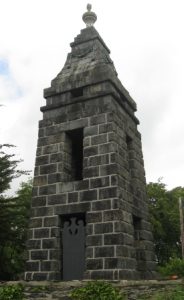
The Great War, 1914-1918
Edward Ellis, Private, 202988, Welsh Regiment. Edward was born on 18 August 1897, the son of Griffith and Margaret Ellis, of Henshop, Llanfrothen. He enlisted at Dolgellau into the 4th Reserve Battalion, Welsh Regiment, and was posted to Pembroke Dock for training. After completing his training he was posted to the 18th Battalion, Welsh Regiment. The battalion was raised in January 1915 as a Bantam Battalion and went to Porthcawl attached to the 43rd (Welsh) Division. In July 1915 it moved to Prees Heath, joining 119 Brigade, 40th (Bantam) Division. On 2 June 1916 the 18th Welsh landed in France and the Division moved to the Loos sector. Late in 1916 the Division moved south to the Somme, and fought at the Battle of the Ancre, remaining in the area over the winter. In March 1917 the Germans withdrew to their shortened line, called the Hindenburg Line, and the 40th Division was one of the Divisions that followed the withdrawal. Later in the year it took part in the Battle of Cambrai, playing an important role in the attack on Bourlon Wood. The wood lies to the north of the Arras to Cambrai road, some three miles west of the strategically important city of Cambrai. The 40th Division relieved the 62nd Division on 23 November and, supported by almost 100 tanks and 430 guns, the Division attacked Bourlon Wood on the morning of 23 November. The Division almost reached the crest of Bourlon Ridge, but became bogged down, and fierce fighting continued over the coming days. Edward was killed during heavy fighting in the wood on 24 November 1917, aged 19. He has no known grave and is commemorated on the Cambrai Memorial, Louverval, France.
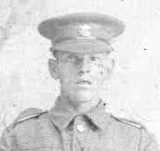
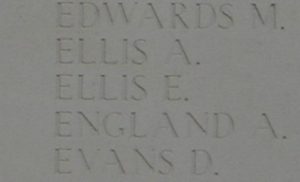
Hugh David Evans, Private, 33937, Yorkshire Regiment. Hugh was the son of Hugh and Sarah Evans, of Tyn-y-Coed, Llanfrothen. He enlisted at Dolgellau into the Royal Army Veterinary Corps, but after completing his training was transferred to the 13th Battalion, Yorkshire Regiment. The battalion landed at Le Havre on 6 June 1916, attached to 121 Brigade, 40th (Bantam) Division and moved to the Loos sector. Late in 1916 it moved south to the Somme, and fought at the Battle of the Ancre, remaining in the area over the winter. In March 1917 the Germans withdrew to their shortened line, called the Hindenburg Line, and the 40th Division was one of the Divisions that followed the withdrawal. Later in the year it took part in the Battle of Cambrai, playing an important role in the attack on Bourlon Wood. The Division remained in the area over the coming months, but was caught up in the German Spring Offensive of 21 March 1918, and saw heavy fighting over the coming days whilst retreating back towards Ervillers. Hugh was killed in action during heavy fighting near St. Leger on 22 March 1918, aged 20. He has no known grave and is commemorated on the Arras Memorial, France.
John Owen Evans, Private, DM2/164817, Royal Army Service Corps. John was the son of John and Jane Evans, of Hendre Gwenllian, Llanfrothen. He worked on the family farm prior to enlisting into the Army Service Corps at Penrhyndeudraeth, and was posted to Aldershot for training. Here John joined the 621st Company, Army Service Corps, and moved to France early in 1916. By December his health had broken down, and John was admitted to hospital in Rouen suffering from pneumonia and pleurisy, and was evacuated to the 2nd London General Hospital in Chelsea. Sadly, his health continued to deteriorate and he died there on 26 March 1917, aged 25. His remains were brought home and he was buried in Ramoth Baptist Cemetery, Llanfrothen.
Richard Rowland Griffith, Lance Corporal, 21080, Royal Welsh Fusiliers. Richard was the son of John and Catherine Griffith, of Penygraig, Croesor. He had moved to 54, Wyndham Street, Porth to work as a collier prior to the war. Richard enlisted at Pontypridd into the Welsh Regiment on 3 March 1913 and was posted to the Depot at Cardiff, but was discharged at his own request a month later, returning to Porth. He then re-enlisted at Abertridwr following the outbreak of war and was posted to the 14th Battalion, Royal Welsh Fusiliers. He joined the battalion at Llandudno, where it was attached to 128 Brigade, 43rd (Welsh) Division. The Division trained in North Wales before moving to Winchester in the summer of 1915, and the formation was renumbered to 113 Brigade, 38th (Welsh) Division. Richard landed in France with the battalion on 2 December 1915, then the entire Division moved to the Nursery Sector near Fleurbaix for trench initiation. The Division then moved to the Cuinchy sector, before marching south to the Somme in June 1916, and famously captured Mametz Wood the following month, during the Somme offensive. The battered Division was then withdrawn, spending a month at Hébuterne before taking over the Canal Bank sector, north of Ypres, where it would remain for the next twelve months. On 12 December 1916 the 14th RWF moved out of the line for a program of training and didn’t move back into the line until 13 January 1917. On 31 January 1917 the battalion was in the line on the Canal Bank sector, carrying out trench improvement work, when Richard was killed, probably whilst on a wiring party. He was 24 years old, and is buried in Bard Cottage Cemetery, Belgium.
David Parry Jones, Private, 49703, Royal Welsh Fusiliers. David was the son of Elias and Alice Jones, of Brynhyfryd, Rhyd, Penrhyndeudraeth. He worked as a quarryman prior to enlisting into the 7th Battalion, Royal Welsh Fusiliers along with his brother Elias following the outbreak of war, but must have been medically downgraded, as he was then transferred to the 2nd (Garrison) Battalion, Royal Welsh Fusiliers. The battalion had sailed from Devonport for Egypt on 6 March 1916 for garrison duties. David took ill towards the end of the war and died of malarial fever at Harieh Hospital, Cairo, Egypt on 1 November 1918, aged 32. He was buried in Cairo War Memorial Cemetery, Egypt. His brother, Elias, died in Egypt in 1916.
Elias Jones, Private, 4325, Royal Welsh Fusiliers. Elias was the son of Elias and Alice Jones, of Brynhyfryd, Rhyd, Penrhyndeudraeth. He worked as a quarryman prior to enlisting at Blaenau Ffestiniog into the 7th Battalion, Royal Welsh Fusiliers along with his brother David following the outbreak of war, and was posted to D Company. The battalion was a Territorial unit, which mobilised for war at Newtown in August 1914, as part of North Wales Brigade, Welsh Division and moved to Conway until the end of the month, before moving to Northampton. In December the Division moved to Cambridge and then in May 1915 to Bedford, where the Division was numbered and the formation became 158 Brigade, 53rd (Welsh) Division. On 19 July 1915 the entire Division sailed from Devonport for Imbros and on 9 August 1915 landed at Suvla Bay. The Division remained at Gallipoli until being evacuated in December 1915 and moved to Egypt, joining the EEF. It then helped guard the Suez Canal defences over the coming months. Elias survived the harsh campaign in Gallipoli, but became ill in Egypt and was hospitalised at Port Said, where he died of dysentery on 5 August 1916, aged 26. He is buried in Port Said War Memorial Cemetery, Egypt. His brother David died in Egypt two years later.
Hugh Jones, Second Lieutenant, Leicestershire Regiment. Hugh was born on 20 January 1887, the son of Owen and Sarah Jones, of Bryn Hyfryd, Croesor, Penrhyndeudraeth. He was educated at Croesor Council School and served an apprenticeship as a Grocer at Llanrwst and Criccieth, before running his own business at Rhyl. He enlisted at Rhyl into the 16th Battalion, Royal Welsh Fusiliers on 14 October 1914 and whilst at Winchester with the battalion underwent an Officers Training course prior to being commissioned into the South Staffordshire Regiment on 20 November 1915. He was then posted to the 7th Battalion, Leicestershire Regiment. He married Elizabeth Ellen Roberts, of Henfryn, Colwyn Bay, on 12 April 1916 and on 15 July 1916 embarked for France with his new battalion, which was attached to 110 Brigade, 37th Division. The Division concentrated near St Omer by 2 August 1915 and moved to the Somme, taking part in the Attack on the Gommecourt Salient, during the first phase of the Battle of the Somme. Hugh was killed in action near Gueudecourt on 27 September 1916, aged 29 and was reported to have been buried in Gird Trench. His grave was lost in further fighting, so Hugh is commemorated on the Arras Memorial, France. His brother John Owen Jones also fell.
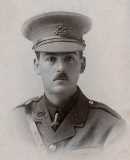
John Owen Jones, Private, 291467, Royal Welsh Fusiliers. John was the son of Owen and Sarah Jones, of Bryn Hyfryd, Croesor, Penrhyndeudraeth. He enlisted at Pwllheli into the 7th Battalion, Royal Welsh Fusiliers. The battalion was a Territorial unit, which mobilised for war at Newtown in August 1914, as part of North Wales Brigade, Welsh Division and moved to Conway until the end of the month, before moving to Northampton. In December the Division moved to Cambridge and then in May 1915 to Bedford, where the Division was numbered and the formation became 158 Brigade, 53rd (Welsh) Division. On 19 July 1915 the entire Division sailed from Devonport for Imbros and on 9 August 1915 landed at Suvla Bay. The Division remained at Gallipoli until being evacuated in December 1915 and moved to Egypt, joining the EEF. It then helped guard the Suez Canal defences over the coming months, helping drive the Turks out of the Sinai before taking part in the offensive into Palestine the following year. The plan for the EEF was to capture the strategically important city of Gaza, so on 26 March 1917, the EEF launched an assault against the city. The attack initially went well, but a thick fog descended on the battlefield, throwing the attack into chaos, and the divisions lost tough with each other. As a result, much of the ground gained was evacuated due to poor communication, and the First Battle of Gaza became a Turkish victory. John was among a large number of men of the 53rd Division killed during the days fighting. The 24-year-old has no known grave, and is commemorated on the Jerusalem Memorial, Israel. His brother, Hugh, also fell.
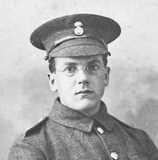
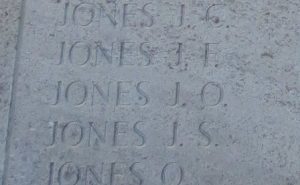
William David Jones, Private, 238010, Yorkshire Regiment. William was born in Llanfrothen in 1890, the son of John and Gwen Jones. Following the death of his father, his mother married Daniel Hughes, and the family moved to 8, Bryncir Terrace, Penmorfa. William enlisted at Carnarvon into the Royal Welsh Fusiliers, and after completing his training was posted to the 4th Battalion, Yorkshire Regiment. The battalion had been in France since 18 April 1915 attached to 150 Brigade, 50th (Northumbrian) Division, and had taken part in the Battle of the Somme the following year. During 1917 it saw heavy fighting at Arras and Passchendaele, and over the winter moved to the St. Quentin sector. The Division was hard hit here during the German Spring Offensive, which was launched on 21 March 1918, and took part in heavy fighting during a gallant rearguard action at the Somme crossings, and as a result was evacuated to Flanders to rest. Unfortunately it became caught up in the second phase of the German offensive, which was launched along the Lys Valley on 9 April, and saw desperate fighting again. The battered Division was then moved to the Aisne, together with several other badly depleted Divisions, and again got caught up in heavy fighting during the third, and last, German offensive, which hit the Aisne sector on 27 May. William was taken prisoner during this tumultuous period, during fighting which saw his battalion decimated. He was taken to Heilsberg POW Camp in Germany, where he remained for the rest of the war. Sadly, like many other PoW’s, he became ill due to the lack of food and poor conditions in captivity, and he died in Heilsberg of pneumonia on 22 November 1918, aged 28. He was buried at Heilsberg Prisoner of War Cemetery, in Germany. Following the end of WW2, the region was ceded to Poland and Heilsberg became Lidzbark Warminski. The cemetery, now called Lidzbark Warminski War Cemetery, in Poland, contained several thousand burials, mainly of Russians and other eastern Europeans who had died as prisoners of war. William is among 39 British prisoners buried in the cemetery, which has only recently been restored by the CWGC. William does not appear to be commemorated locally.
William Kellow, Second Lieutenant, Royal Air Force. William was born on 19 November 1892, the son of Alderman Moses Kellow and Nell Kellow, of Bryn Croesor, Penryndeudraeth. He was educated at Porthmadog County School and then at Dulwich, prior to going to Cambridge University, gaining his BA in 1911. He then took up a position at Gonville & Caius, Cambridge, where he was on the Mechanical Science Honours course and after graduating, he went out to South Africa, taking up a position at the Ginsburg Gold Mine, near Johannesburg. He enlisted into the Royal Flying Corps, and after training as a pilot was commissioned in October 1917. He went over to France early in 1918, just before the Royal Flying Corps merged with the Royal Naval Air Service to form the Royal Air Force, and joined 22 Squadron, which was equipped with the Bristol F.2 Fighter. On 16 September 1918 William was flying Bristol E2519 over German lines, when he was attacked by a superior force of German aircraft. After a brief fight, his aircraft was shot down and crashed between Cambrai and Douai, killing William and his Observer, Second Lieutenant Felton. The two men were initially posted as missing, but on the following day were found by the Germans who buried them at Aubigny-au-Bac Churchyard. After the war both graves were exhumed and re-buried in Naves Communal Cemetery Extension, France.
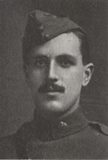
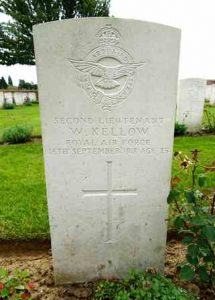
Daniel Owen, Pioneer, 130586, Royal Engineers. David was the son of John and Ann Owen, of Llys Brothen, Penrhyndeudraeth. He enlisted into the 3/7th Battalion, Royal Welsh Fusiliers on 6 December 1915 and was posted to Park Hall Camp, Oswestry. On 25 March 1916 he was transferred to the regular army and posted to the Royal Engineers. On 19 May 1916 Daniel was posted to the 4th Battalion, Special Brigade, which was a unit specialising in the discharge of poison gas from cylinders, and was still in the Loos sector. The battalion must have suffered a catastrophe soon afterwards, as a large number of its personnel were killed and wounded during an incident on 27 June 1916. Daniel died of gas poisoning at the 4th London Field Ambulance, France on 28 June 1916, aged 19, so must have been wounded on the previous day. He is buried in Fosse No. 10 Communal Cemetery Extension, Sains-en-Gohelle, France. His brother Evan was killed the following year.
Evan Owen, Stoker 2nd Class, K/43043, Royal Navy. Evan was born on 2 November 1897, the son of John and Ann Owen, of Llys Brothen, Penrhyndeudraeth. He enlisted into the Royal Navy on 6 June 1917, and was posted to HMS Vivid II at Devonport for training. He was posted to the battleship HMS Implacable, at Portsmouth, on 11 August 1917, for further training. Once he had completed his training, he was posted aboard the destroyer HMS Brisk. On 2 October 1917 HMS Brisk was part of the escort group to Convoy HH24, steaming south-west of County Antrim. A German U-Boat, U-79 attacked the Convoy, hitting the cruiser HMS Drake, so the Convoy dispersed and Brisk was deployed to follow some of the dispersed Merchant ships. Steaming through Rathlin Sound a massive explosion blew the bow off Brisk, killing 31 sailors. Whether she had been torpedoed or struck a mine is unclear, but the stern of Brisk remained afloat and was towed into Londonderry. Evan was among the 31 men killed during the explosion. The 20-year-old has no known grave and is commemorated on the Plymouth Naval Memorial, Devon. His brother, Daniel, had been killed the previous year.
Owen Evan Owen, Sailor, Mercantile Marine. Owen was the son of Evan Owen and Catherine Owen (nee Evans), of Cefn Meusydd, Penrhyndeudraeth. Owen followed in his father’s footsteps and went to sea as a young man, and by 1911 was serving as a ship’s cook aboard the schooner Elizabeth Roberts. He served throughout the war, in one of the most dangerous services, the Mercantile Marine, and survived the conflict. Sadly, he was drowned whilst serving aboard the SS Joseph Davis, a cargo ship, when she struck rocks and sank with all hands whilst en-route from Cardiff for Gibraltar on 10 February 1919. Owen was 26 years old. He is not commemorated by the CWGC, as his ship, the Joseph Davis, was not a war loss.
Samuel Owen, Sapper, 155488, Royal Engineers. Samuel was the son of John and Anne Owen, of Penybwlch, Penrhyndeudraeth. He married the widowed Jane Hughes in 1906 and by 1914 he was living with her at 22, Susannah Place, Treharris, where he worked as a Haulier. Samuel enlisted into the 20th Battalion, Welsh Regiment at Treharris on 29 June 1915, and was posted to Rhyl, where the reserve battalions for the Welsh Division were training. On 13 March 1916 Samuel was transferred to the Royal Engineers, and was posted to France, initially joining the Special Brigade, Royal Engineers, which were the gas warfare specialists. He was then transferred to the 250th Tunnelling Company, Royal Engineers. The Company was stationed in the Ypres Salient, and worked on some of the underground mines beneath Messines Ridge. These mines, some 26 in all, although some failed to detonate, were blown at 20 second intervals starting from 3.10 am on 7 June 1917, followed by an infantry assault. The explosions could be heard in London and are still today regarded as the largest non-nuclear explosions in history. Samuel was shot in the stomach by a sniper during the days after the explosion and was evacuated to No 2 Casualty Clearing Station at Bailleul where he died of his wounds on 23 June 1917, aged 31. He is buried in Bailleul Communal Cemetery Extension, France,
David Matthias Williams, Sergeant, 240101, Royal Welsh Fusiliers. David was the son of Evan and Catherine Williams, of Bryntirion, Rhyd, Llanfrothen. By 1911 he was lodging at Colwyn Bay, where he worked as a Bank Clerk for the London City & Midland Bank. David enlisted at Colwyn Bay into the 5th Battalion, Royal Welsh Fusiliers on 11 January 1911. The battalion was a Territorial unit, attached to North Wales Brigade, Welsh Division and over the next few years, David attended Annual Camp at Lamphey, Carnarvon and at Rhyl. Following the outbreak of war, he was he mobilised with the battalion, which joined North Wales Brigade at Conwy, and moved to Northampton at the end of August 1914. On 13 May 1915 the formation became 158 Brigade, 53rd (Welsh) Division, and on 19 July sailed from Devonport for Imbros, before landing at Suvla Bay on 9 August 1915. Following the evacuation from Gallipoli the Division moved to Egypt, but David soon took ill and was hospitalised before being sent home on 27 January 1916. Once he had recovered, he was posted back out to Egypt on 9 September 1916 and took part in the Divisions advance into Palestine the following year, fighting at the three Battles of Gaza and in the capture of Jerusalem and Jericho. David survived the war, and following the Armistice the Division moved to Alexandria, where the 5th and 6th Battalions of the RWF merged to become the 5/6th Battalion. He took ill soon afterwards and died of broncho-pneumonia on 20 January 1919, aged 26. David is buried in Alexandria (Hadra) War Memorial Cemetery, Egypt. He is also commemorated on the Colwyn Bay War Memorial. His brother, David Morris Williams, was killed at sea in 1917.
David Morris Williams, Seaman Cook, Mercantile Marine. David was the son of Evan and Catherine Williams, of Bryntirion, Rhyd, Llanfrothen. He worked as a tailor at Porthmadog prior to the war and married Jane Williams, of Station House, Porthmadog, in 1915. David volunteered to serve in the Mercantile Marine and was posted aboard the Sailing Vessel Ellen James, which was based at Porthmadog under Master Richard Cadwallader Jones, of Criccieth. On 3 April 1917 Ellen James was sailing west of Ushant, returning from Huelva to Penrhyn, carrying a cargo of copper pyrites, when she was stopped by the German submarine UC-71. The submarine then proceeded to fire her deck gun at the helpless schooner, sinking her with the loss of five of her crew of six, including two men from Penrhyndeudraeth, David and John Thomas Roberts. David was 32 years old when he was killed in the sinking of Ellen James, and is commemorated on the Tower Hill Memorial, London. David is also commemorated at Porthmadog. His brother, David Matthias Williams, died in Egypt in 1919.
Robert David Williams, Private, 69252, Royal Welsh Fusiliers. Robert was the son of David and Annie Williams, of Beddgelert. He enlisted into the Royal Welsh Fusiliers, and after completing his training was posted to France, joining the 2nd Battalion, Royal Welsh Fusiliers, which was attached to 19 Brigade. The battalion had been in France since 11 August 1914, and had a very interesting and well documented war. Upon joining 19 Brigade, the Brigade became attached to the 6th Division on 12 October 1914, then to the 27th Division on 31 May 1915. On 19 August 1915 the Brigade joined the 2nd Division, and then three months later moved to the 33rd Division. The Division saw its first major action during the Battle of the Somme, from July 1916 onwards. It then fought at the Battle of the Scarpe and at Bullecourt, before heading to Ypres, and fought at the Menin Road and at Polygon Wood. The Division wintered at Ypres, taking turns in the front line on Passchendaele Ridge. On 4 January 1918 the 2nd RWF moved up from reserve at Brandhoek and relieved the 7th DLI in the Passchendaele trenches. Robert was wounded soon after this and died of his wounds on the following day, 5 January 1918, aged 22. He is buried in Tyne Cot Cemetery, Belgium. The cemetery lies on the ridge, so he must have died very soon after being wounded. Robert’s parents later moved to 14, Peckers Hill Road, Sutton, St. Helens, Lancs.
William David Williams, Private, 12318, Gloucestershire Regiment. William was the son of Owen and Ellen Williams, of Llanfrothen. The family had moved to 23, Penn Street, Treharris at sometime between 1911 and 1914. William enlisted at Ferndale into the Gloucestershire Regiment and after completing his training, was posted to France on 10 February 1915, joining the 1st Battalion, Gloucestershire Regiment, which was attached to 3 Brigade, 1st Division. The Division had seen heavy fighting during the previous months, taking part in the retreat from Mons to the Marne, and had taken heavy casualties during the First Battle of Ypres. William was sent out to the battalion as one of 63 reinforcements who joined up with it at Cauchy-à-la-Tour, near Auchel, on 14 February. The Division then moved to the Maroc/ Loos sector to begin a tour in the line there. On 9 May 1915, the Battle of Aubers Ridge opened. Among the attacking Divisions was the 1st Division, which was unrecognisable from the experienced unit which had first landed in France in August 1914. The 1st Division advanced behind a screen of gas, which blew back into their own trenches, and reinforcements had to be pushed forwards immediately due to the many casualties suffered by their own gas screen. Terrible casualties were suffered during the day, for no gain. Among the dead was 21-year-old William. He has no known grave and is commemorated on the Le Touret Memorial, Richebourg-L’avoue, France.
William Richard Williams, Private, 203672, Royal Welsh Fusiliers. William was the son of John and Dorothy Williams, of Pen-y-Bwlch Cottage, Penrhyndeudraeth. He worked as a cowman prior to enlisting at Dolgellau into the 4th Reserve Battalion, Royal Welsh Fusiliers on 21 January 1917, and was posted to Wrexham for training. He landed in France on 2 August 1917 and was sent to No 5 Infantry Base Depot. On 17 August 1917 William was posted to the 16th Battalion, Royal Welsh Fusiliers, which was at Ypres attached to 113 Brigade, 38th (Welsh) Division. The Division had taken part in the assault on Pilckem Ridge on 31 July 1917, suffering heavy casualties in its successful advance to the Steenbeek. William was among a number of reinforcements posted to the battalion to help rebuild its numbers. William joined up with the 16th RWF at Persia Camp, near Sainte-Sixte. On 9 September the battalion marched to Proven, and the entire 38th Division entrained, beginning its move from Ypres to new positions at Sailly-Sur-La-Lys, where it remained over the winter. The Germans launched their Spring Offensive on the Somme on 21 March 1918, and the 38th Division was sent south, to relieve the battered 2nd and 47th Divisions, and took up positions facing Thiepval Ridge. In front of the Division was the German held Bouzincourt Ridge, which afforded views across the Ancre Valley to Thiepval, so the Division was ordered to drive the Germans back across the river. At dawn on 22 April 1918 the 16th RWF launched their attack, behind a creeping artillery barrage, but was hit by heavy machine-gun fire and the attack failed. The battalion had suffered the loss of 5 officers and 38 men killed; 8 died of wounds; two officers and 20 men missing and two officers and 159 men wounded. Among the missing was William, who was afterwards adjudged to have been killed in action during the attack. The 19-year-old has no known grave and is commemorated on the Pozieres Memorial, France.
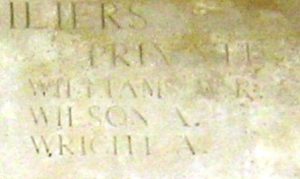
World War Two, 1939-1945
Christopher Moelwyn Strachey Williams-Ellis, Lieutenant, 228337, Welsh Guards. Christopher was the son of Sir Clough Williams-Ellis and Amabel Williams-Ellis (nee Strachey), of Plas Brondanw, Llanfrothen. He was educated at King’s College, Cambridge and following the outbreak of war gained a commission into the Welsh Guards, as did his father in WW1. He was posted to the 3rd Battalion, Welsh Guards, which was formed on 24 October 1941. The Battalion sailed for North Africa on 5 February 1943, landing in Algiers, and moved to El Aroussa, to join the 1st Guards Brigade. The battalion fought during the last months of the North African campaign. In February 1944 the Battalion moved to Italy, and began to move Monte Cerasola. The Battle of Monte Cassino was by now underway. The Monastery Hill formed an important part of the German Gustav Line Defences, and formed an impenetrable barrier to the advancing Allies, and heavy fighting took place for several months. Christopher was killed whilst the 1st Guards Brigade was holding the ground around Monte Cerasola on 13 March 1944, aged 22. He is buried in Minturno War Cemetery, Italy.
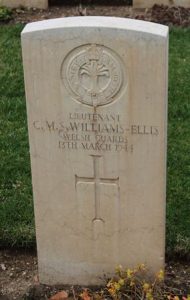
John William Hughes, Private, 7604454, Royal Army Ordnance Corps. John was the son of John Roberts Hughes and Rhoda Hughes (nee Smith), of 1, Danwdeg, Llanfrothen. He enlisted into the Royal Army Ordnance Corps, and was posted to East Africa to take part in the campaign against the Italian forces based in the stronghold of Keren. The town fell to the Allies at the end of March 1941 and the retreating Italian force was pursued to Asmara, which was occupied on 1 April. John then became part of the garrison stationed at Asmara. He died there on 7 April 1942, aged 26, and is buried in Asmara War Cemetery, Eritrea.
Edward John Jones, Able Seaman, C/JX 169489, Royal Navy. Edward was born on 23 January 1919, the son of Maggie J. Jones, of Minffordd. He enlisted into the Royal Navy, and after completing his training was posted aboard the heavy cruiser, HMS Cornwall. She had spent most of her pre-war service assigned to the China Station, but following the outbreak of war was assigned to search for German commerce raiders in the Indian Ocean. Cornwall transferred to the South Atlantic in late 1939, to take part in convoy escort duties, but after the start of the Pacific War in December 1941, was transferred to the Eastern Fleet. On 4 April 1942, Cornwall HMS Dorsetshire set out from harbour following reports of the sighting of a Japanese Fleet. On the following day, the two cruisers were sighted by a Japanese aircraft, some 200 miles south-west of Ceylon. On 5 April 1942, the two cruisers were attacked by a wave of Japanese dive-bombers, and were sunk with the loss of 424 lives. Over 1,100 survivors spent over a day in the sea before being rescued. Edward was 23-years-old when he was killed in the sinking of HMS Cornwall, and is commemorated on the Chatham Naval Memorial, Kent.
Richard Jones, Fusilier, 4203855, Royal Welch Fusiliers. Richard was the son of Ellis and Elizabeth Jones, of Llwyn, Llanfrothen. He enlisted into the 7th Battalion, Royal Welch Fusiliers, which was the local Territorial army unit, attached to 158 Brigade, 53rd (Welsh) Division. The Division moved to Northern Ireland following the outbreak of war, then moved to southern England, where it remained until landing in Normandy on 25 June 1944. The Division moved off the beaches in support of the 50th Division, and on 1 July took over a section of the front line near Mondrainville, before advancing over the River Odon the following day, and saw its first action of the war when it came into contact with Germans at the village of Gaurus. On 14 July the 53rd Division received orders to take up the offensive, and two days later the assaulting battalions moved forwards to their assembly positions east of Mondrainville in preparation for an assault against positions along the Evrecy to Eterville road. Richard was killed during the 7th RWF assault on the Farm de Mondeville on the following morning, 17 July 1944. He was 32 years old and is buried in Banneville-La-Campagne War Cemetery, France.
Tegwyn Pierce Roberts, Fusilier, 4198854, Royal Welch Fusiliers. Tegwyn was born at Llanfrothen on 24 March 1917, the illegitimate son of Mary Roberts. By 1939 he was living with his mother at 13, Cwmorthin Road, Tanygrisiau, where he worked as a slate quarrier. Tegwyn enlisted into the Royal Welch Fusiliers early in the war and was posted to the Barracks at Wrexham for training. He died at Wrexham on 27 September 1940, aged 23 and was brought home for burial in Llanfrothen Cemetery. Tegwyn is not commemorated on the Llanfrothen memorial.
Thomas John Whitford, Sapper, 4207274, Royal Engineers. Thomas was the son of William Henry Whitford and Ivy Whitford (nee Clift), of Glyncorrwg, Glamorgan. He married Margaret Pritchard, of Brondanw Uchaf, Penrhyndeudraeth, in 1943. Thomas enlisted into the Royal Engineers, and was posted to Italy soon after marrying, joining the 10th Railway Construction Company, RE. The company was one of a number sent out to Italy following the Allied invasion, in order to repair the railways and rail infrastructure which had been destroyed by the Germans during their slow withdrawal north. Thomas died in Italy on 3 June 1945, aged 24, and is buried in Forli War Cemetery, Italy.